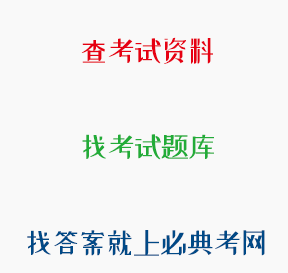正确答案:
题目:阅读下面的材料,按要求作文。
20世纪30年代,梅兰芳先生初到上海,虽然他唱功绝佳,誉满京华,但要在大上海一下子出名也难。当时想在报纸上登广告,但广告怎么写,才能引起人们的注意呢?经过一番筹划,戏班子决定在报纸上只印三个字--梅兰芳。当时上海的市民并不知道梅兰芳是谁,因为好奇,都在互相打听,连登了一周之后,报纸上登出了一个详细的广告:"梅兰芳--京剧名旦,今晚在上海茶戏园登台献艺。欢迎观看。"就这样,先生在上海一唱走红。
综合上述材料所引发的思考和感悟,写一篇不少于800字的论说文。
要求:
用规范的现代汉语写作,角度自选,立意自定,标题自拟。
解析:【解析】(一)评分标准:
一等(50-38)紧密围绕教育背景、教师身份写作,立意切合"教师的职业光辉伟大""教师的工作职责"等题意,中心突出,内容充实、情真意切、结构严谨、文体明确、语言优美、引经据典、字体优美;(教育学、心理学、教师职业素养,结合教育场景、学生心理,站在教育事业发展、教育体制改革的维度书写)
二等(37-25)站在教师立场思考主题,中心符合"教师应具备哪些知识技能""教师应具备那些专业素质"等角度,中心明确,内容较充实、感情真实、结构完整,文体突出、语言通顺、字迹清楚:(符合教师的职业素养,稍微联系理论和现实)
三等(24-12)中心基本符合题意、基本明确,内容单薄、感情基本真实、结构基本完整、文体基本符合、语言基本通顺、字迹潦草:
四等(11-0)"三观"观念错误,中心偏离题意、不明或立意不当、内容空洞、文体不明、矫揉造作、结构混乱、语病多、字迹难辨。(不具备作为教师的基本素质和辨别是非的能力,基本写作能力欠缺)
(二)写作硬性扣分项目:写作与文章相关的硬伤主要集中在内容残缺和语言表达基本功上,主要几大硬性扣分项目有:标题:不写,扣5分;文章结尾:不写,字数多于600字,扣10分;少于600字,残文11分以下;语句错误:2个扣1分,5个扣3分,多余5个,字句错误降等,降12分。
查看原题 查看所有试题
学习资料的答案和解析:
[单选题]"字字写来都是血,十年辛苦不寻常"是对( )的评价。
《红楼梦》
解析:题干是曹雪芹自己对红楼梦的评说:浮生着甚苦奔忙,盛席华筵终散场。悲喜干般同幻渺,古今一梦尽荒唐。漫言红袖啼痕重,更有情痴抱恨长。字字写来皆是血,十年辛苦不寻常。故选择C。A选项,《水浒传》作者施耐庵(元末明初);B选项,《窦娥冤》作者关汉卿(元);D选项,《西游记》作者吴承恩(明)。
[单选题]新课程改革后,学生的学习方式转变为"自主学习"、"合作学习"和( )。
研究性学习
解析:本题考查的是新课改关于学习方式的表述。新课改提出的改被动接受的学习方式为"自主、合作、探究式学习"。故选择D。
[单选题]从现代认知心理学的观点看,创造力培养的最好途径是( )。
在重视基础知识、基本技能的同时,注意解决问题策略训练
解析:从现代认知心理学的观点看,创造力培养的最好途径是在重视基础知识和技能的同时,注意解决问题策略训练。
[单选题]以下现象,不属于学习的迁移的是( )。
由于画画得很好,小张在美术社表现很出色
解析:本题考查了迁移的定义。学习迁移也称训练迁移,是指一种学习对另一种学习的影响,或习得的经验对完成其他活动的影响。ABD选项,均说明的是一种学习对另一种学习的影响,属于迁移现象。C选项,单纯表现的是小张的绘画能力强,并没有涉及两种学习之间的相互影响,故不属于学习迁移。
[单选题]学习迁移产生的客观条件是( )。
学习对象之间的共同要素
解析:学习迁移产生的客观条件是学习对象之间的共同要素。故选择C。
[单选题]通过平行四边形的判断训练,学生对长方形面积的判断的成绩提高,而对三角形、圆形、不规则图形的判断的成绩没有提高。可用于解释这种现象的迁移理论是( )。
共同要素说
解析:共同要素说认为,只有当学习情境和迁移测验情境存在共同成分,一种学习才能影响另一种学习,即才会产生学习的迁移,两个完全不相似的刺激反应联结之间,不可能产生迁移,这会使人对迁移产生悲观态度。
[单选题]请阅读 Passage 1,完成1~5小题。
Passage 1
In the field of psychology,there has long been a certain haziness surrounding the definition of creativity,an I-know-it-when-I-see-it attitude that has eluded a precise formulation.During our conversation,Mark Beeman,a cognitive neuroscientist at Northwestern University,told me that he used to be reluctant to tell people what his area of study was,for fear of being dismissed or misunderstood.What,for instance,crosses your mind when you think of creativity? Well,we know that someone is creative if he produces new things or has new ideas.And yet,as John Kounios,a psychologist at Drexel University who collaborates frequently with Beeman,points out,that view is wrong,or at least not entirely right."Creativity is the process,not the product," he says.
To illustrate,Beeman offers an example.Imagine someone who has never used or seen a paperclip and is struggling to keep a bunch ofpapers together.Then the person comes up with a new way of bending a stiff wire to hold the papers in place. "That was very creative," Beeman says.On the flip side,if someone works in a new field-Beeman gives the example of nanotechnology-anything that he produces may be considered inherently "creative".But was the act of producing it actually creative? As Beeman put it,"Not all artists are creative.And some accountants are very creative."
Insight,however,has proved less difficult to define and to study.Because it arrives at a specific moment in time,you can isolate it,examine it,and analyze its characteristics."Insight is only one part of creativity," Beeman says."But we can measure it.We have a temporal marker that something just happened in the brain.I'd never say that's all of creativity,but it's a central, identifiable component." When scientists examine insight in the lab.they are looking at what types of attention and thought processes lead to that moment of synthesis: If you are trying to facilitate
a breakthrough,are there methods you can use that help? If you feel stuck on a problem,are there tricks to get you through?
In a recent study,Beeman and Kounios followed people's gazes as they attempted to solve what's called the remote-associates test,in which the subject is given a series of words,like "pine" "crab" and "sauce" and has to think of a single word that can logically be paired with all of them.They wanted to see if the direction of a person's eyes and her rate ofblinking could shed light on her approach and on her likelihood of success.It turned out that if the subject looked directly at a word and focused on it-that is,blinked less frequently,signaling a higher degree of close attention-she was more likely to be thinking in an analytical,convergent fashion,going through possibilities that made sense and systematically discarding those that didn't.If she looked at "pine" say,she might.be thinking of words like "tree" "cone" and "needle" ,then testing each option to see if it fit with the other words.When the subject stopped looking at any specific worD.either by moving her eyes or by blinking,she was more likely to think of broader,more abstract associations.That is a more insight-oriented approach."You need to learn not just to stare but to look outside your focus," Beeman says.(The solution to this remote-associates test: "apple" .)
As it turns out,by simple following someone's eyes and measuring her blinks and fixation times,Beeman's group can predict how someone will likely solve a problem and when she is nearing that solution.That's an important consideration for would-be creative minds: it helps us understand how distinct patterns of attention may contribute to certain kinds ofinsights.
In PARAGRAPH FOUR,which of the following shows the purpose of describing the experiment?
To discern connection between close attention and insights.
解析:细节题。根据第三段中的“When scientists examine insight in the lab,they are looking at what types of attention and thought processes lead to that moment of synthesis",当科学家们在实验室检测洞察力时,他们所观察的是何种类型的注意力和思维过程可以带来顿悟,即实验目的是通过对比实验中的两种观察和思维方式,来了解注意力与洞察力之间的相互作用。故本题选B。

 川公网安备 51012202001360号
川公网安备 51012202001360号